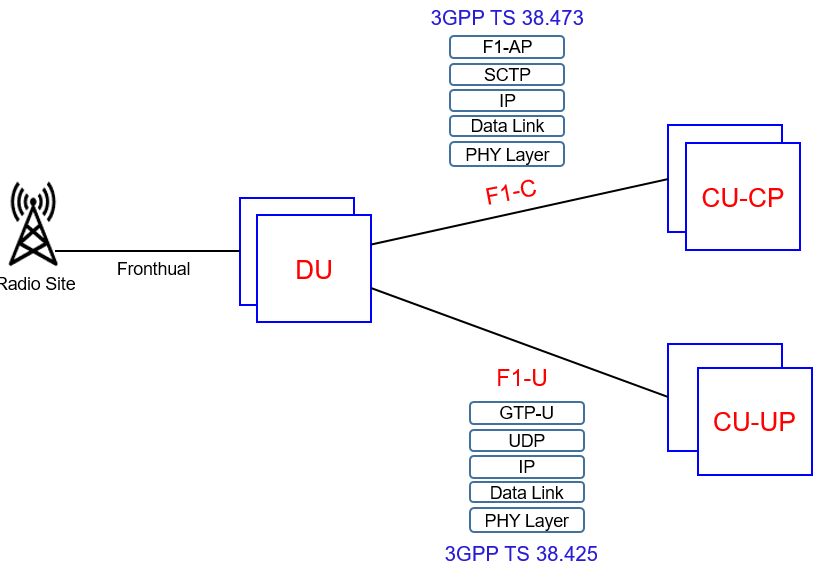Open Midhaul in 5G: A Deep Dive into F1-C and F1-U Interfaces
telcomatraining.com – As 5G technology continues to revolutionize mobile communications, network architecture must evolve to support the high throughput, low latency, and flexible deployment models required by next-generation services. One key architectural innovation is the concept of Open Midhaul — a standardized interface between the Distributed Unit (DU) and the Centralized Unit (CU) within the Radio Access Network (RAN). This interface is primarily governed by two protocol layers: F1-C (Control Plane) and F1-U (User Plane).
In this article, we explore the technical details and significance of the F1-C and F1-U interfaces, shedding light on how Open Midhaul facilitates multi-vendor interoperability, scalability, and overall network efficiency in 5G deployments.
Understanding the Open Midhaul Concept
In traditional mobile networks, RAN components were tightly integrated and often supplied by a single vendor. This vertical integration limited flexibility and created vendor lock-in. With 5G, the industry has shifted toward disaggregated RAN, where the RAN is split into three parts:
- Radio Unit (RU)
- Distributed Unit (DU)
- Central Unit (CU)
The Open Midhaul interface lies between the DU and CU, enabling flexible placement of these units across the network based on latency and bandwidth requirements. The F1 interface (standardized by 3GPP) supports this connection and is split into two distinct layers: F1-C and F1-U.
What is F1-C?
F1-C stands for F1-Control and handles the signaling between the DU and CU. Its primary responsibilities include:
- Establishing and managing RRC (Radio Resource Control) connections
- Handling handovers between cells
- Managing bearer configuration and context setup
- Controlling system information broadcasts
By isolating control functionalities, F1-C allows for centralized control logic in the CU while minimizing the processing burden on the DU. This separation enhances scalability and supports edge-cloud deployments.
What is F1-U?
F1-U, or F1-User, manages the actual user data transfer between the DU and CU. Key roles of the F1-U interface include:
- Transporting user plane data packets
- Handling Quality of Service (QoS) parameters
- Supporting data forwarding during mobility procedures
F1-U must operate with ultra-low latency to ensure real-time data flow, particularly for applications like AR/VR, autonomous vehicles, and industrial IoT.
Benefits of Using F1-C and F1-U in Open Midhaul
Implementing the F1-C and F1-U split architecture provides multiple advantages:
- Multi-vendor Interoperability
With standardized interfaces, network operators can deploy DU and CU components from different vendors, fostering innovation and cost efficiency. - Scalability and Flexibility
Open Midhaul allows operators to distribute network functions optimally, scaling up or down based on demand, geography, or use-case-specific needs. - Edge Computing Readiness
DUs can be deployed closer to users (at the edge), while CUs remain centralized, supporting faster processing and lower latency. - Simplified Maintenance and Upgrades
Operators can upgrade the CU independently of the DU, streamlining network operations and reducing downtime.
Challenges and Considerations
Despite its benefits, Open Midhaul and the F1 interface model present certain challenges:
- Synchronization Requirements
Precise timing and synchronization between DU and CU are critical for performance. - Security Concerns
Open interfaces may introduce vulnerabilities if not adequately protected. - Complexity in Integration
Ensuring seamless interoperability between multi-vendor components can require extensive testing and certification.
Conclusion
Open Midhaul architecture, underpinned by F1-C and F1-U interfaces, is a cornerstone of the 5G network evolution. It offers a flexible, modular, and future-proof approach to building Radio Access Networks that meet the demands of ultra-fast, reliable, and scalable mobile services. As 5G matures, the adoption of open, standardized interfaces will continue to play a vital role in unlocking its full potential.







